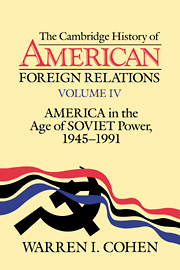Book contents
- Frontmatter
- Prelude
- 1 At war’s end: visions of a new world order
- 2 Origins of the Cold War
- 3 The Korean War and its consequences
- 4 New leaders and new arenas in the Cold War
- 5 Crisis resolution
- 6 America’s longest war
- 7 The rise and fall of Détente
- 8 In God’s country
- Conclusion: America and the world, 1945–1991
- Bibliographic essay
- Index
- THE CAMBRIDGE HISTORY OF AMERICAN FOREIGN RELATIONS
- References
1 - At war’s end: visions of a new world order
Published online by Cambridge University Press: 28 March 2008
- Frontmatter
- Prelude
- 1 At war’s end: visions of a new world order
- 2 Origins of the Cold War
- 3 The Korean War and its consequences
- 4 New leaders and new arenas in the Cold War
- 5 Crisis resolution
- 6 America’s longest war
- 7 The rise and fall of Détente
- 8 In God’s country
- Conclusion: America and the world, 1945–1991
- Bibliographic essay
- Index
- THE CAMBRIDGE HISTORY OF AMERICAN FOREIGN RELATIONS
- References
Summary
Allied forces returned to France in June 1944 and were soon battling their way inland from the Normandy beaches. In Washington, President Franklin D. Roosevelt knew that the defeat of Germany was on the horizon, the fall of Japan not far beyond. His thoughts and those of other American leaders, in and out of government, turned increasingly to the postwar world: What legacy would he leave the American people? How could he and his associates ensure an enduring peace and a prosperous America? What lessons could be learned from past failures, especially those that had followed World War I, the inability to stop the economic misery and aggressive violence of the 1930s?
Roosevelt and his colleagues expected the United States to emerge from the war as the greatest power on earth. And after this war, unlike the aftermath of World War I, they were determined to assert American leadership. This time they would create a world order conducive to the interests of the United States, which would allow it to increase its wealth and power, and carry its values to every corner of the globe. There would be no shirking of the responsibilities of power. The United States would provide the leadership necessary to create a liberal international economic order, based on free trade and stable currency-exchange rates, providing a level of prosperity the peoples of the world had never known. The United States would provide the leadership necessary to prevent the resurgence of German or Japanese power or the rise of others who might emulate Hitler and the Japanese militarists.
- Type
- Chapter
- Information
- The Cambridge History of American Foreign Relations , pp. 3 - 20Publisher: Cambridge University PressPrint publication year: 1993



